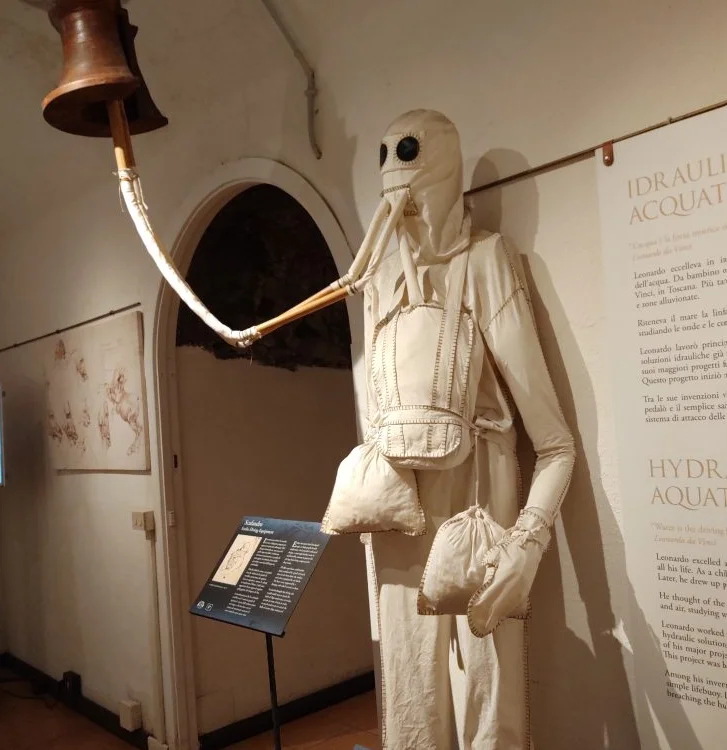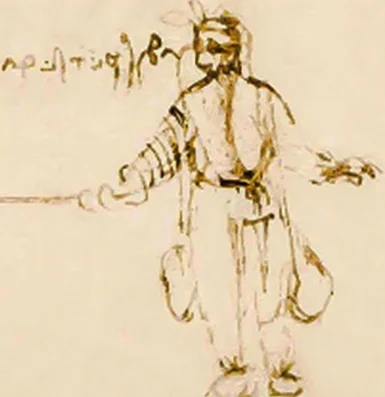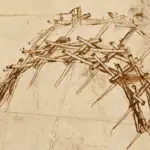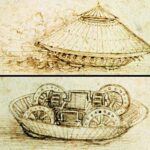
Leonardo da Vinci Diving Suit
Leonardo da Vinci diving suit is a captivating illustration of his boundless imagination and inventiveness.
This suit, designed in the 16th century, was intended to allow underwater sabotage by enabling men to cut holes in enemy ship hulls. However, due to a lack of funding, the concept never got past the blueprint stage.
For those intrigued by historical inventions, the details of da Vinci’s design offer a fascinating glimpse into early ideas of underwater exploration.
The suit included a leather outfit with a mask featuring cane tubes, ropes, and weapons. Though it was never built, this vision highlighted da Vinci’s ability to envision technology far beyond his time.
Interest in da Vinci’s works often centers on his art, yet his engineering feats reveal an equally significant aspect of his genius.
Exploring his inventions, such as the diving suit, allows us to appreciate his contributions to art and science. The intersection of creativity and practicality in his designs reminds us of the endless possibilities imagined by one of history’s greatest minds.
The Concept of the Leonardo da Vinci Diving Suit
Leonardo da Vinci’s diving suits were among his many inventive ideas. His conceptual designs, which reflected his innovative spirit, aimed to equip people with tools for underwater exploration and military use.
Overview of Leonardo da Vinci’s Inventions Diving Suit
The Leonardo da Vinci diving suit was designed with a leather body and a bag-like mask for the head. Da Vinci included cane tubes for breathing, connected to a floating device above the water. This design reveals his understanding of underwater air supply needs.
The suit’s drawing shows advanced thinking for his time, with the intricate details reflecting da Vinci’s desire to push the boundaries of technology.
Modern assessments highlight how his suits, though never built during his life, were precursors to later diving equipment.
The Purpose Behind the Da Vinci Diving Suit
Da Vinci’s idea for the diving suit was primarily military. He envisioned using it to sabotage enemy ships by cutting holes in their hulls from below the waterline. The diving suit design by Leonardo da Vinci was not only a piece of engineering but also a strategic tool in naval warfare.
His suit also suggests curiosity about human capabilities under the sea. By designing suits that allowed extended stays underwater, Leonardo explored ways humans could interact with and manipulate the environment below the surface.
Historical Context of Diving Gear in the Renaissance
During the Renaissance, diving gear was rudimentary and lacked the sophistication of Leonardo’s ideas. Most diving attempts relied on simple tools like ropes and weights.
The da Vinci diving suit concept was groundbreaking. It proposed a new approach to underwater exploration before modern scuba gear existed.
His work shows a shift in the Renaissance mindset towards innovation and scientific exploration. Though the suit was never realized in his lifetime, it remains a testament to his visionary approach and understanding of engineering principles.
When Was the Diving Suit Invented?

Leonardo da Vinci Diving Suit Sketch
The development of diving suits traces back to Leonardo da Vinci’s inventive vision. His ideas sparked innovations, influencing various designs that followed. Key elements of his sketches remain relevant today.
Timeline of Leonardo da Vinci’s Diving Suit Development
Leonardo da Vinci began conceptualizing his diving suit around 1485 in Venice. He envisioned it as a tool for military strategy, aiming to protect the city by sending men underwater to sabotage enemy ships.
This Leonardo da Vinci diving suit invention featured a leather outfit with a bag-like mask and breathing tubes designed to reach the surface and supply air.
Though plans existed, there is limited evidence to suggest he constructed the suit. Despite this, his sketches offered a foundation for imagining human exploration beneath the waves and inspired future inventors.
Comparison with Other Historical Diving Suits
Da Vinci’s inventions set a precedent for other diving suits that emerged centuries later. In 1602, Jerónimo de Ayanz y Beaumont developed another early model.
Compared to later suits, da Vinci’s design lacked the practicality and safety of more advanced suits like the ones designed in the 18th and 19th centuries.
The introduction of metal helmets and air pumps significantly improved divers’ experience and safety. This evolution demonstrates an important progression in diving technology, while da Vinci’s early concepts offered groundwork for these improvements.
The Influence of Da Vinci’s Design on Modern Diving Gear
Leonardo da Vinci’s scuba suit ideas laid the groundwork for future advancements in underwater exploration. Many of the design elements he envisioned underpin modern innovations in diving gear.
For instance, his use of air supply mechanisms predated and influenced the development of scuba technology.
Features of the Leonardo da Vinci Underwater Diving Suit
The Leonardo da Vinci underwater diving suit is an innovative creation that reflects his genius in tackling the challenges of underwater exploration. This invention features unique design elements, thoughtful material selection, and intriguing functionality.
Unique Design Elements of the Diving Suit Leonardo da Vinci Created
Leonardo da Vinci’s diving suit stands out due to its remarkable design. The suit included a bag-like mask covering the diver’s head, allowing them to see and breathe easily. Attached to this mask were cane tubes resembling modern snorkels. These tubes provided a way to breathe while submerged.
The suit’s design was purposeful, targeting naval warfare and utility in defending against invaders. The conceptual elements highlight da Vinci’s foresight and inventive approach, offering unique insights into his thinking.
Materials and Construction of the Leonardo da Vinci Scuba Gear
The diving suit was made using readily available materials of the time. It is comprised of leather, a durable and flexible choice well-suited to crafting the main body of the suit. Leather’s natural properties offered some protection against underwater elements and allowed for necessary movement.
Additionally, the air tubes were crafted from cane, a lightweight and functional material for breathability. These elements show a balance between innovation and practicality. Da Vinci’s choice of materials reflects an understanding of their properties and how they could work together to form an effective diving suit.
Analyzing the Functionality of the Diving Suit
Examining the functionality reveals a well-thought-out strategy for underwater operations. Thanks to its clever air supply method, the suit was designed to allow divers to stay submerged for extended periods. By enabling divers to breathe underwater, da Vinci envisioned using the suit for strategic military maneuvers.
While the da Vinci diving suit was never built to its full potential, the design demonstrates how it might have performed effectively in its intended role. Its concept hints at a multifunctional tool that could have changed approaches to marine conflict.
Did Leonardo da Vinci’s Diving Suit Work?
Leonardo da Vinci’s diving suit, designed in the 16th century, intrigues historians and engineers alike. This section explores whether this invention could function as intended and why it garnered such interest.
Testing the Theories: Did the Da Vinci Diving Suit Function?
Leonardo da Vinci’s diving suit was likely not tested during his lifetime. He created designs for a leather suit equipped with a breathing tube. This tube allowed air supply from the surface, intended for underwater activities. However, no evidence exists that the suit was ever constructed or used.
Without records or prototypes, it’s unclear if the design truly worked. Today, historians speculate about its potential practicality and effectiveness for underwater endeavors.
Expert Opinions on the Effectiveness of Leonardo’s Design
Experts agree that Leonardo’s design was ahead of his time. The diving suit’s concept featured elements like a buoyancy control system, which still influences modern scuba gear.
However, some argue that limitations in materials and technology during Leonardo’s era would have made his suit impractical. Many reinforce that while the idea was genius, it couldn’t succeed back then due to insufficient resources and a lack of detailed execution.
Modern Interpretations of the Leonardo da Vinci Diving Suit Facts
Today’s researchers often analyze Leonardo da Vinci’s diving suit design to understand its historical context and potential use. His suit inspires modern submariners and historians, who appreciate its visionary aspects.
The design also continues to capture the imagination of artists and innovators, supporting themes of creativity and exploration. These studies highlight how Leonardo’s ideas inspired developments in underwater exploration technologies despite being purely theoretical in his time.
Artistic Representations of the Diving Suit
Leonardo da Vinci, a master of blending art and innovation, designed a unique diving suit. These designs are not just historical artifacts but an artistic testament to his genius, influencing the evolution of visual art and diving technology.
The Leonardo da Vinci Diving Suit Drawing: A Closer Look
The Leonardo da Vinci diving suit drawing showcases his foresight and creativity. In it, da Vinci depicts a suit made from waterproof leather with breathing tubes.
This artwork highlights his ability to combine aesthetic appeal with practical engineering solutions. Da Vinci’s attention to detail is evident in the representation of the suit’s components, which are clearly illustrated to reveal their function and potential use underwater.
Insights from the Leonardo da Vinci Diving Suit Sketches
The diving suit sketches provide critical insights into Leonardo da Vinci’s inventions, such as the diving suit. His designs included large pockets, a component meant to address buoyancy issues.
It reflects his complex problem-solving approach, aiming to adapt human anatomy for undersea exploration.
The sketches serve as an educational tool, showing da Vinci’s ingenious methods and foresight in envisioning solutions for underwater navigation, which were way ahead of his time.
The Impact of Da Vinci’s Diving Suit Design on Art and Science
Da Vinci’s diving suit design transcends mere invention; it had a lasting impact on art and science. The da Vinci scuba suit design fundamentally influenced future depictions of diving apparatuses.
Artists and designers drew inspiration from his innovative approach, which married form and function.
His designs laid the groundwork for modern diving technology in science, showcasing da Vinci’s role as a pioneer who bridged creativity and functionality, inspiring both fields for centuries.
Closing Remarks
Leonardo da Vinci’s diving suit is a fascinating insight into his innovative mind. It was designed for military purposes and showcased Leonardo’s attention to engineering and human capability.
While it was never built in his lifetime, his sketches offer a glimpse into potential advancements in diving technology.
The suit featured a leather design with a bag-like mask for the diver’s head. It included attached cane tubes for air supply, indicating Leonardo’s understanding of the need for breathable air underwater.
While deemed impractical at the time, this early conceptualization paved the way for future developments in scuba gear.
Despite its impracticalities, such as the challenge of rebreathing exhaled air, Leonardo’s idea was ahead of his time. Today’s diving suits have evolved significantly, yet they still echo the spirit of exploration that da Vinci’s design embodied.
Key Takeaways: Leonardo da Vinci’s diving suit reflects his forward-thinking approach. While not feasible in his era, his ideas laid the groundwork for future innovations in diving technology. This early dive into underwater exploration remains a testament to his genius and curiosity.
Frequently Asked Questions
Leonardo da Vinci’s contributions to diving technology have ignited curiosity about the diving suit he designed. His inventions often straddled the line between art and science, and new questions arise when examining these remarkable creations.
Did Leonardo da Vinci make the diving suit?
Leonardo da Vinci did not build a functional diving suit himself. He created sketches and designs for one in Venice around 1500.
These designs were intended for military use, allowing divers to conduct underwater missions against enemy ships. The suit was imaginative but was never constructed in his time.
Who invented the diving suit?
Although Leonardo da Vinci designed the concept of a diving suit, the first practical scuba suit was not developed until centuries later.
Augustus Siebe, a German-born engineer, is credited with inventing the first closed-circuit diving suit in the 19th century, which laid the groundwork for modern diving gear.
What did Leonardo da Vinci do with the parachute?
Leonardo da Vinci also sketched plans for a pyramidal parachute to allow a safe descent from heights.
However, unlike his diving suit, Leonardo did not build the parachute himself. A modern test in 2000 confirmed that it could work.
What was the purpose of the diving suit?
The primary purpose of Leonardo da Vinci’s diving suit was for military applications. Da Vinci designed it for covert operations, allowing divers to approach enemy ships underwater.
It featured a leather suit, a face mask, and breathing tubes made of cane to draw air from the surface.
Was da Vinci jacked?
Leonardo da Vinci was known more for his intellect and artistic talents than his physical build. There is no historical evidence or documentation to suggest that he was notably muscular or “jacked” in a modern sense.
Who invented scuba gear?
Jacques Cousteau, a French naval officer, and Émile Gagnan, an engineer, are credited with inventing the first modern scuba gear, the Aqua-Lung, in the 1940s. This gear allowed divers to explore underwater with greater freedom than ever before.
What was Leonardo da Vinci’s most significant invention?
One could argue that Leonardo da Vinci’s most significant invention was his conceptualization of numerous devices such as the helicopter or armored vehicle.
His immense contribution to various fields often overshadows specific single inventions. His designs have inspired future generations in science, engineering, and art.
How much did the Leonardo da Vinci vessel cost?
The question about the cost of the Leonardo da Vinci vessel seems to be a misunderstanding. Da Vinci’s work did not include building ships or boats.
However, if this refers to a modern ship named after him, specific cost information would depend on the ship’s specifications and purpose.
Did da Vinci design a tank?
Yes, Leonardo da Vinci designed an early tank concept. His design included a covered vehicle with cannons arranged in a circle for offensive military use.
It is one of his many visionary sketches and was not constructed in his lifetime.
Who tested Leonardo da Vinci’s parachute?
Leonardo da Vinci did not live to test his parachute design. In 2000, a British skydiver named Adrian Nicholas successfully tested a parachute based on da Vinci’s sketch.
The parachute worked as intended, validating Leonardo’s innovative concept centuries later.
 I’m Leonardo Bianchi, the mind behind Leonardo da Vinci's Inventions. Thanks for visiting.
I’m Leonardo Bianchi, the mind behind Leonardo da Vinci's Inventions. Thanks for visiting. 


